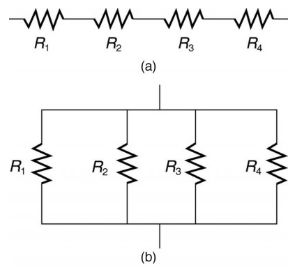Resistors are widespread in electronic equipment and are common components of electrical networks and electronic circuits. As discrete components, practical resistors can be made of a variety of compounds and shapes. Resistors are also used in integrated circuits. High-power resistors, which can dissipate many watts of electrical power as heat, can be employed in motor controllers, power distribution systems, or as generator test loads. The resistances of fixed resistors vary only slightly with temperature, time, or operating voltage. Variable resistors can be used to alter circuit elements (such as a volume control or a lamp dimmer) or as heat, light, humidity, force, or chemical activity sensors.
Resistors in series and parallel
Resistor in Series
When the passage of charge, known as current, must pass through devices consecutively, resistors are connected in series. If current passes through a person holding a screwdriver and into the Earth, R1 may represent the resistance of the screwdriver’s shaft, R2 the resistance of the screwdriver’s handle, R3 the resistance of the person’s body, and R4 the resistance of her shoes. A series connection of resistors to a voltage source is shown in the figure. Given that the current must flow through each resistor in sequence, it appears plausible that the total resistance is the sum of the individual resistances,the total resistance Rs of a series connection is:
Rs = R1 + R2 + R3+…+Rn

Resistor in parallel
The resistors are connected in parallel when they are connected directly to the voltage source by connecting cables with low resistance. As a result, each resistor receives the entire voltage from the source. Each resistor pulls the same amount of current as if it were connected directly to the voltage source (provided the voltage source is not overloaded).For example, the headlights, radio, and other components of a car are wired in parallel so that they can use the entire voltage of the source and work completely independently. The same is true in your home or any other structure.

Resistors colour code
The four band resistor colour code can be utilised to produce less precision resistors with tolerances of 5%, 10%, and 20%. There are a few simple guidelines for determining resistor values. For example, in a four-band resistor, the first two colours represent the most critical numbers for the resistance value. Each colour band is assigned a number ranging from 0 to 9, and these bands will generally decode distinct numbers into a discernible code.
In a four-colour band resistor, for example, the first two colour bands are brown and red, and the values are 1 and 2.The third band provides the multiplier (power of ten), which indicates that the two significant bits should be multiplied by the same allocated value for each colour as in the previous phase (if the band colour is 2, multiply it by 2 to get 102 = 100, else add two zeros). In the preceding example, the resistor value would be 1200 or 1.2k.If the multiplier band is silver or gold, the decimal point can be relocated to the left via one or two places in the preceding example.The tolerance value and colour are then assigned to each tolerance. The tolerance for gold is ±5%, and the tolerance for silver is ±10%.
Resistors failure causes
Oxidation is one of the most common causes of resistor failure. The most common cause of oxidation is operating the resistor at an incorrect temperature. Each resistor is rated for a specific temperature. Operating it at temperatures over this level usually results in beneficial changes in resistance. This is caused by oxidation.Underestimating the ambient temperature of a circuit is a typical issue, with underestimation being more common than overestimation.As a result, to avoid overheating and oxidation, you may want to derate a resistor positioned near a power transistor or power resistor, reducing the possibilities of failure.
A circuit fault is another factor that might cause a resistor to misbehave or fail completely. If, for example, a malfunctioning circuit causes the resistor to operate at a wattage higher than its rated wattage for an extended period of time, it will very certainly fail.
Excess energy is a third cause of resistor failure to consider. Excess energy causes excess temperature, which leads to resistance variations on a regular basis.Voltage stress is a typical cause of resistor failure as well.
Conclusion
Components such as resistors can be colour coded to identify their resistance levels, tolerance, and so on. The wattage rating is indicated by the size of the resistor. In general, the resistance, wattage rating, and tolerance values of big power resistors are marked on the resistor with letters or numbers. However, for small resistors, it is printed in small letters, allowing resistor parameters to be stated in a different fashion.
 Profile
Profile Settings
Settings Refer your friends
Refer your friends Sign out
Sign out






